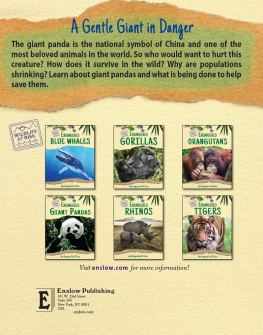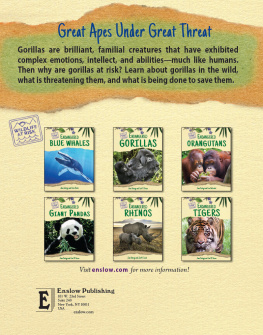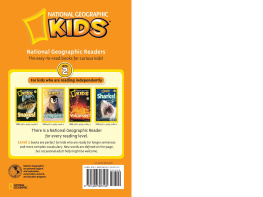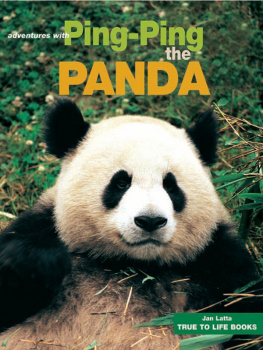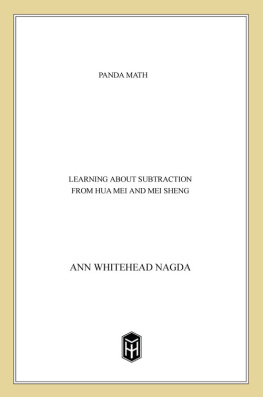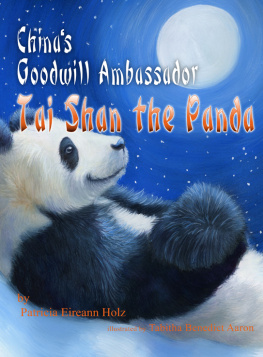Carl R. Green - Endangered Giant Pandas
Here you can read online Carl R. Green - Endangered Giant Pandas full text of the book (entire story) in english for free. Download pdf and epub, get meaning, cover and reviews about this ebook. year: 2015, publisher: Enslow Publishing, LLC, genre: Children. Description of the work, (preface) as well as reviews are available. Best literature library LitArk.com created for fans of good reading and offers a wide selection of genres:
Romance novel
Science fiction
Adventure
Detective
Science
History
Home and family
Prose
Art
Politics
Computer
Non-fiction
Religion
Business
Children
Humor
Choose a favorite category and find really read worthwhile books. Enjoy immersion in the world of imagination, feel the emotions of the characters or learn something new for yourself, make an fascinating discovery.
- Book:Endangered Giant Pandas
- Author:
- Publisher:Enslow Publishing, LLC
- Genre:
- Year:2015
- Rating:4 / 5
- Favourites:Add to favourites
- Your mark:
- 80
- 1
- 2
- 3
- 4
- 5
Endangered Giant Pandas: summary, description and annotation
We offer to read an annotation, description, summary or preface (depends on what the author of the book "Endangered Giant Pandas" wrote himself). If you haven't found the necessary information about the book — write in the comments, we will try to find it.
The giant panda is the national symbol of China and one of the most beloved animals in the world. So who would want to hurt this creature? How does it survive in the wild? Why are populations shrinking? Learn about giant pandas and what is being done to help save them.
Endangered Giant Pandas — read online for free the complete book (whole text) full work
Below is the text of the book, divided by pages. System saving the place of the last page read, allows you to conveniently read the book "Endangered Giant Pandas" online for free, without having to search again every time where you left off. Put a bookmark, and you can go to the page where you finished reading at any time.
Font size:
Interval:
Bookmark:

Published in 2016 by Enslow Publishing, LLC.
101 W. 23rd Street, Suite 240, New York, NY 10011
Copyright 2016 by Enslow Publishing, LLC.
All rights reserved.
No part of this book may be reproduced by any means without the written permission of the publisher.
Library of Congress Cataloging-in-Publication Data
Katirgis, Jane, author.
Endangered giant pandas / Jane Katirgis and Carl R. Green.
pages cm. (Wildlife at risk)
Summary: Discusses giant pandas, why they are endangered, and how they are being helped--Provided by publisher.
Audience: Ages 11+.
Audience: Grades 7 to 8.
Includes bibliographical references and index.
ISBN 978-0-7660-6894-0 (library binding)
ISBN 978-0-7660-6892-6 (pbk.)
ISBN 978-0-7660-6893-3 (6-pack)
1. Giant pandaJuvenile literature. 2. Endangered speciesJuvenile literature. 3. Giant panda ConservationJuvenile literature. I. Green, Carl R., author. II. Title.
QL737.C27K374 2016
599.789dc23
2015010125
Printed in the United States of America
To Our Readers: We have done our best to make sure all Web site addresses in this book were active and appropriate when we went to press. However, the author and the publisher have no control over and assume no liability for the material available on those Web sites or on any Web sites they may link to. Any comments or suggestions can be sent by e-mail to .
Portions of this book originally appeared in the book The Giant Panda.
Photos Credits: AP Photo/Ng Han Guan, p. (panda).
Cover Credits: Wolfgang Kaehler/LightRocket via Getty Images (panda); Creativ Studio Heinemann/ Creative (RF)/Getty Images (borage flowers); Joakim Leroy/E+/Getty images (palm leaf); Maria Toutoudaki/Photodisk/Getty Images (background paper texture).
GIANT PANDAS AT A GLANCE
Scientific Name
Ailuropoda melanoleuca. The Chinese call the giant panda da xiong mao (dah-shong mah-oo)the large cat-bear.
Closest Relatives
The giant panda is most often classified as a member of Ursidaethe bears. As a bear, its closest relative is the South American spectacled bear.
Other scientists argue that the giant panda is a member of Procyonidaethe raccoons. In that family, its closest relative would be the red panda.
Current Habitat
All wild giant pandas live in the dense bamboo forests of the mountains of western China.
Size and Weight*
Adult Male: Length: 4 to 6 ft. (1.2 to 1.8 m)
Height: 27 to 32 in. (69 to 81 cm)
Weight: 230 lbs. (104 kg)
Adult Female: Length: 3.5 to 4.5 ft.(1.1 to 1.4 m)
Height: 24 to 30 in. (61 to 76 cm)
Weight: 198 lbs. (89.8 kg)
Diet
Giant pandas feed on the shoots, leaves, and stems of the bamboo. In one year, an adult panda can consume more than ten thousand pounds of bamboo. On occasion, pandas also eat fish, small rodents, honey, and flowering plants.
Current Populations
Estimates place the wild population of giant pandas at about 1,600. Another 300 live in zoos and breeding centers, most of which are in China.
Special Adaptations
The giant panda uses a thumb-like wrist bone to grasp bamboo stalks. Its thick, dense coat protects it from cold, snow, and rain at altitudes as high as 10,500 feet (3,200 m).
Life Span
In the wild: about 2022 years.
In captivity: up to 30 years.
Vocalizations
Giant pandas have a large vocabulary. They chirp during mating, honk in times of stress, and bark or click their teeth to frighten enemies. A squeal signals submission or pain, and a bleating, goat-like sound indicates a friendly contact.
Main Threats
Habitat destruction, poaching, periodic die-offs of bamboo, and loss of genetic diversity.
Legislative Status
In the United States, pandas are protected by the Endangered Species Act of 1973. Zoos that want to import pandas must follow strict rules from the Fish and Wildlife Service. China created the first of its giant panda reserves in 1963.
Organizations Working to Save the Panda
Center for Reproduction of Endangered Species
China Wildlife Conservation Association
World Wildlife Fund
Zoological Society of San Diego; Zoo Atlanta; National Zoological Park; Memphis Zoo
*Figures represent average measurements.
chapter one
MEET AILUROPODA MELANOLEUCA
Perhaps you think it is just a typical day at the zoo. Children delight in the antics of the sea lions at feeding time. Spectators watch in awe as a tiger paces around its cage. Not far away, children giggle as a kangaroo rat bounces through its home at the mammal house. In another exhibit, a giraffe stretches its endlessly long legs.
As it turns out, this is far from being a normal day. The zoo has just welcomed some new guests. Follow the surging crowd to the enclosure where Ailuropoda melanoleuca lives. There is the zoos new star calmly munching a bamboo stalk. Someone whispers, Shes a real live black-and-white teddy bear! You do not need a sign to tell you that you are face-to-face with Chinas best-loved visitorthe giant panda.
People Love Pandas
Why do people adore the giant panda? Scientists believe the answer lies in the pandas nonthreatening looks. Like toddlers, pandas have large heads and round, flat faces. Also like babies, their bodies give the illusion of being soft and cuddly. Even the pandas eyes look big and gentle thanks to its black eye patches.
Of course, giant pandas are ten times the size of a human baby. Even so, these slow-moving bamboo eaters inspire joy, not fear. Watch a panda at play. You cannot help but smile to see it turn in clumsy somersaults. If a soccer ball is thrown into the pen, the panda will likely play a lively gameuntil its sharp claws rip the ball to shreds.

Chinese philosophy, art, and science are all affected by the concept of yin and yang. This relates to the ideal of opposites living together in perfect harmony. The panda is considered a living example of yin and yang because it is so comfortable in its coat of black-and-white fur.
Fast Fact!
A newborn panda is only as large as a stick of butter.
A zookeeper answers questions about the giant panda. Her listeners look upset when she confirms that the species is in danger of extinction. Unlike animals such as snail darters and crested toads, people deeply care about pandas. That fact led the World Wildlife Fund (WWF) to pick the giant panda as its symbol. Today, a black-and-white panda logo carries the WWFs conservation message across the globe.
Giant Panda Legend
There are many stories about how the panda got its patches of black fur. An old Tibetan legend tells us that pandas once were as white as polar bears. In that long-ago time, a panda cub played with a flock of sheep tended by four sisters. One day a leopard sprang at the cub. The sisters grabbed their shepherds crooks and tried to chase the predator away. In the confusion, the cub escaped. The angry leopard turned on the girls and killed them.
All of Chinas giant pandas came to the funeral. As a sign of their grief, they wore black armbands. When they hugged, cried, and wiped their eyes, their tears caused the dye in the armbands to run. Each hug and pat left a black splotch on their white fur. When they saw what had happened, the pandas vowed never to wash off the black markings. Later, the pandas turned the girls graves into a mountain with four tall peaks. The mountain still stands in Sichuan Province near the Wolong Nature Reserve. Villagers call it Siguniangthe Four Sisters Mountain.
Font size:
Interval:
Bookmark:
Similar books «Endangered Giant Pandas»
Look at similar books to Endangered Giant Pandas. We have selected literature similar in name and meaning in the hope of providing readers with more options to find new, interesting, not yet read works.
Discussion, reviews of the book Endangered Giant Pandas and just readers' own opinions. Leave your comments, write what you think about the work, its meaning or the main characters. Specify what exactly you liked and what you didn't like, and why you think so.

